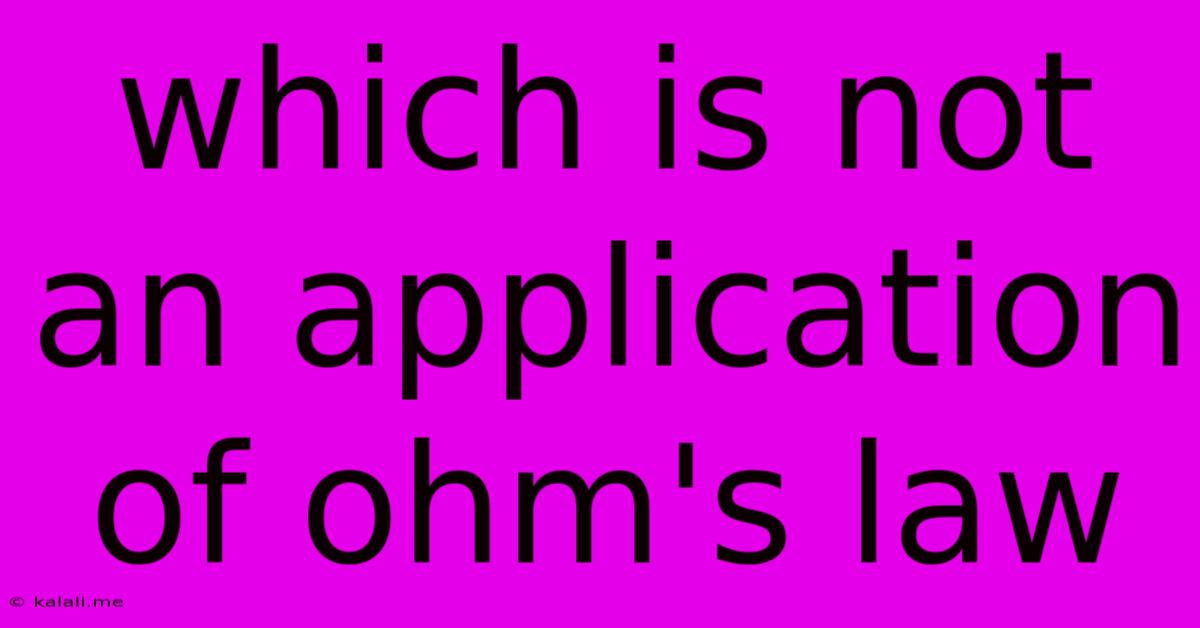Which Is Not An Application Of Ohm's Law
Kalali
Jun 15, 2025 · 2 min read

Table of Contents
Which is NOT an Application of Ohm's Law? Understanding the Limitations
Ohm's Law, a cornerstone of electrical engineering, states that the current through a conductor between two points is directly proportional to the voltage across the two points and inversely proportional to the resistance between them. This simple relationship, often expressed as V = IR, is incredibly useful for circuit analysis. However, it's crucial to understand that Ohm's Law isn't a universal truth applicable to all electrical situations. This article explores scenarios where Ohm's Law doesn't apply.
Understanding the Scope of Ohm's Law: Before diving into exceptions, remember that Ohm's Law applies to materials exhibiting ohmic behavior. This means their resistance remains constant regardless of the applied voltage or current. Many common conductors, like copper wires, behave ohmically within a specific range of conditions.
Key Scenarios Where Ohm's Law Fails:
Several situations demonstrate the limitations of Ohm's Law:
-
Non-Ohmic Materials: Many materials don't exhibit a linear relationship between voltage and current. These are called non-ohmic materials. Examples include:
- Diodes: These semiconductor devices allow current to flow easily in one direction but significantly restrict flow in the opposite direction. Their resistance changes dramatically depending on the voltage polarity and magnitude.
- Transistors: Similar to diodes, transistors are semiconductor devices whose resistance is controlled by a small control current, making their behavior highly non-linear.
- Light Bulbs (Incandescent): The filament's resistance increases significantly as it heats up with increasing current. This makes the relationship between voltage and current non-linear.
- Electrolytes and Ionized Gases: These substances exhibit varying resistance due to changes in temperature and ion concentration.
-
High-Frequency AC Circuits: At very high frequencies, the effects of capacitance and inductance become significant. These reactive components store and release energy, influencing the current flow independently of resistance, making Ohm's Law insufficient for accurate analysis.
-
Superconductors: These materials exhibit zero resistance below a critical temperature. Ohm's Law doesn't apply because there's no resistance to consider.
-
Nonlinear Circuit Elements: Any circuit element that doesn't exhibit a linear relationship between voltage and current will invalidate the application of Ohm's Law. Examples include:
- Zener Diodes: These diodes maintain a nearly constant voltage across a wide range of currents, defying the linear relationship expected from Ohm's Law.
In Summary:
While Ohm's Law is an invaluable tool for basic circuit analysis involving ohmic materials and low-frequency currents, it's essential to recognize its limitations. Understanding the conditions under which Ohm's Law doesn't hold is crucial for accurately analyzing more complex circuits and electronic components. Ignoring these limitations can lead to inaccurate calculations and potentially problematic designs. Always consider the nature of the material and the operating conditions before applying Ohm's Law.
Latest Posts
Latest Posts
-
Which Of The Following Is True Of Qualitative Research
Jun 15, 2025
-
Number Of Chromosomes In Fruit Fly
Jun 15, 2025
-
Parts Of 4 Stroke Petrol Engine
Jun 15, 2025
-
Conversion Of Voltage Source To Current Source
Jun 15, 2025
-
Which Of The Following Is Not A Market Segmentation Approach
Jun 15, 2025
Related Post
Thank you for visiting our website which covers about Which Is Not An Application Of Ohm's Law . We hope the information provided has been useful to you. Feel free to contact us if you have any questions or need further assistance. See you next time and don't miss to bookmark.